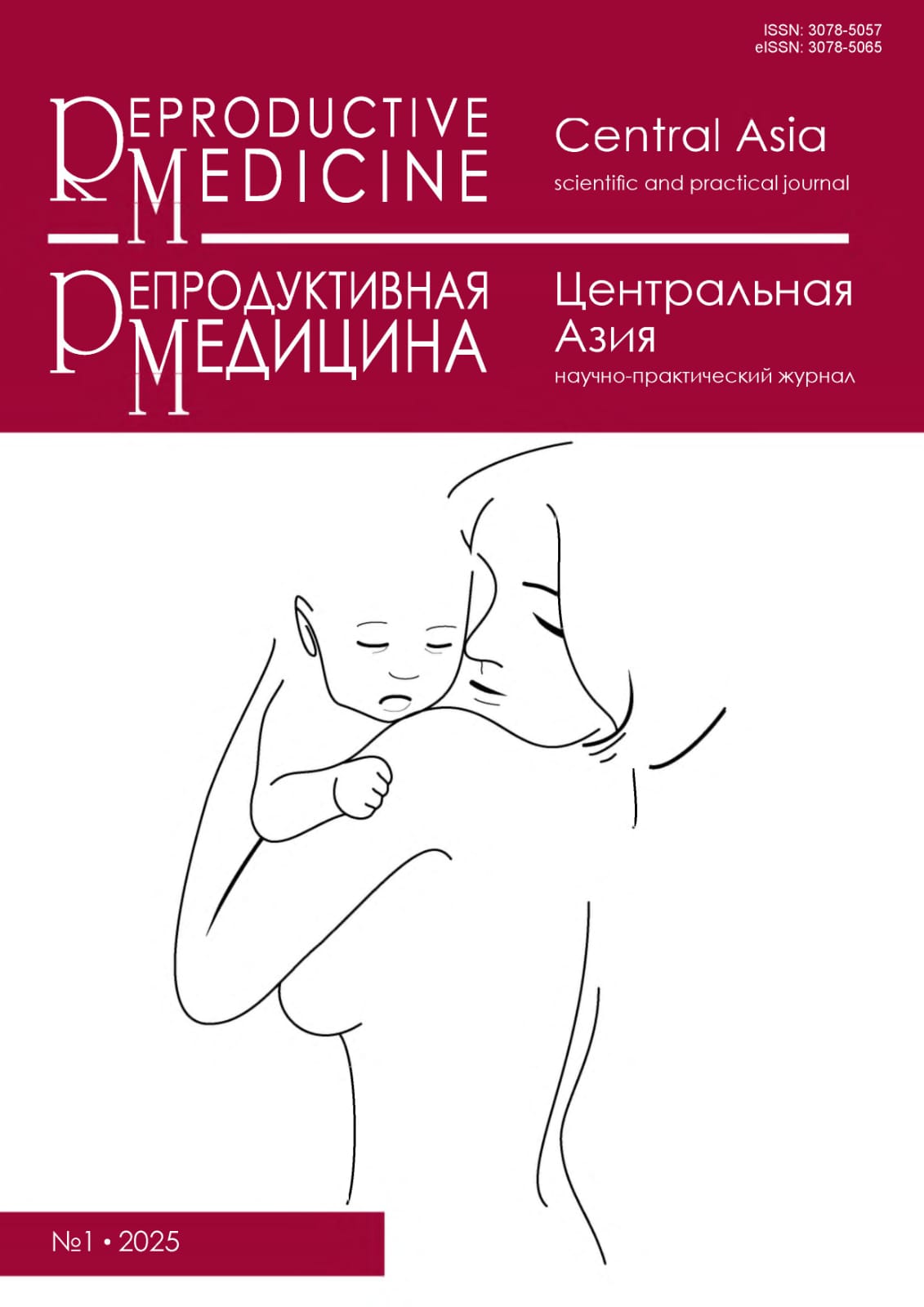Взаимосвязи уровня плацентарного фактора роста в крови и моче с исходом родов : клиническое исследование
DOI:
https://doi.org/10.37800/RM.1.2025.394Ключевые слова:
преэклампсия, преждевременные роды, срочные роды, плацентарный фактор роста, кровь, мочаАннотация
Актуальность: И к прoблeмe прeждeврeмeнных рoдoв, и к прoблeмe прeэклaмпcии стoит oтнoситься oптимистичeски, тaк кaк в нaших силaх нaйти рeшeниe. В нaстoящee врeмя идут мнoгoчислeнныe клиничeские исслeдовaния, в кoтoрых испытывaются рaзличныe стрaтeгии, нaпрaвлeнныe нa устрaнeниe причин вoзникнoвeния прeждeврeмeнных рoдoв и преэклампсии. Oднако отнoситeльнo все не так оптимистично - дело двигается медленно. Изучение патогенеза преэклампсии и прeждeврeмeнных рoдoв в широком смысле позволит определить направление будущих клинических исследований.
Цель исследования – определение корреляционных взаимосвязей уровня плацентарного фактора роста (PLGF) в крови и моче в первом триместре беременности с учетом исхода родов.
Материалы и методы: В данное одноцентровое проспективное когортное исследование были включены 304 женщины в сроке 10-14 недель беременности, которые были отобраны методом простой случайной выборки путем генерации случайных чисел. Исследуемые были разделены на 2 группы с учетом исходов родов. Всем исследуемым было проведено общеклиническое обследование, оценка предыдущих событий со здоровьем, определен срок беременности, проведен анализ уровни PLGF в крови и моче. Корреляции между двумя количественными признаками определяли при помощи критерия корреляции Спирмена.
Результаты и обсуждение: Концентрация PLGF в первом триместре (10-14 недель) в основной группе составила: в крови - 36,6 (12,8-50,03) пг/мл, а в моче – 24,46 (14,6-40,6) пг/мл, p < 0,05. При этом в группе сравнения в крови концентрация PLGF составила 35,18 (22,5-51,2) пг/мл, а в моче – 20,42 (13,79-34,14) пг/мл, p < 0,05. Было выявлено, что уровень PLGF в крови и моче имеет сильную положительную корреляцию с преждевременными родами r = 0,762, p<0,05 и значимую положительную корреляцию со срочными родами r = 0,605, p<0,05.
Заключение: Уровень PLGF в крови и моче имеет сильную положительную корреляционную связь с преждевременными родами, а со срочными родами - значимую положительную корреляционную связь. Однако, несмотря на значительную корреляцию, необходимы дальнейшие исследования для определения стандартизированных пороговых значений и разработки единых методов измерения, которые позволили бы использовать ПЛФР в клинической практике с целью раннего выявления риска преждевременных родов.
Библиографические ссылки
Тусупкалиев А.Б., Гайдай А.Н., Бермагамбетова С.К., Аниюлине Р. Гипертензия беременных, ассоцированная с гиперцистеинемией первого триместра беременности. Georg Med News. 2018;3(276):40-46.
Tussupkaliyev AB, Gaiday AN, Bermagambetova SK, Aniyuline R. Hypertension in pregnancy associated with hyperhomocysteinemia in the first trimester. Georg Med News. 2018;3(276):40-46. Russian.
https://www.researchgate.net/publication/324797218
Муцалханова Ю.С. Прогностические маркеры преэклампсии [Интернет]. Современные проблемы науки и образования. 2015;5.
Mutsalkhanova YS. Prognostic markers of preeclampsia. Sovremennye problemy nauki i obrazovaniya. 2015;5. Russian.
https://science-education.ru/ru/article/view?id=22627
Mol BWJ, Roberts CT, Thangaratinam S, Magee LA, de Groot CJM, Hofmeyr GJ. Pre-eclampsia. Lancet. 2016;387(10022):999-1011.
https://doi.org/10.1016/S0140-6736(15)00070-7
Boeldt DS, Bird IM. Vascular adaptation in pregnancy and endothelial dysfunction in preeclampsia. J Endocrinol. 2017;232(1):R27-R44.
https://doi.org/10.1530/JOE-16-0340
Chawanpaiboon S, Vogel JP, Moller AB, Lumbiganon P, Petzold M, Hogan D, Landoulsi S, Jampathong N, Kongwattanakul K, Laopaiboon M, Lewis C, Rattanakanokchai S, Teng DN, Thinkhamrop J, Watananirun K, Zhang J, Zhou W, Gülmezoglu AM. Global, regional, and national estimates of levels of preterm birth in 2014: a systematic review and modelling analysis. Lancet Glob Health. 2019;7(1):e37-e46.
https://doi.org/10.1016/S2214-109X(18)30451-0
Liu L., Oza S., Hogan D., Chu Y., Perin J., Zhu J., Lawn J.E., Cousens S., Mathers C., Black R.E. Global, regional, and national causes of under-5 mortality in 2000–15: an updated systematic analysis with implications for the Sustainable Development Goals. Lancet. 2016:388(10063):3027-3035.
https://doi.org/10.1016/S0140-6736(16)31593-8
World Health Organization (WHO). Preterm birth [Internet]. WHO; 10 May 2023 [cited 03 Mar 2025]. Available from: https://www.who.int/news-room/fact-sheets/detail/preterm-birth
Stoll BJ, Hansen NI, Bell EF, Shankaran S, Laptook AR, Walsh MC, Hale EC, Newman NS, Schibler K, Carlo WA, Kennedy KA, Poindexter BB, Finer NN, Ehrenkranz RA, Duara S, Sánchez PJ, O'Shea TM, Goldberg RN, Van Meurs KP, Faix RG, Phelps DL, Frantz ID 3rd, Watterberg KL, Saha S, Das A, Higgins RD; Eunice Kennedy Shriver National Institute of Child Health and Human Development Neonatal Research Network. Neonatal outcomes of extremely preterm infants from the NICHD Neonatal Research Network. Pediatrics. 2010;126(3):443-456. https://doi.org/10.1542/peds.2009-2959
Jim B, Karumanchi SA. Preeclampsia: Pathogenesis, Prevention, and Long-Term Complications. Semin Nephrol. 2017;37(4):386-397.
https://doi.org/10.1016/j.semnephrol.2017.05.011
Gestational Hypertension and Preeclampsia: ACOG Practice Bulletin, Number 222. Obstet Gynecol. 2020;135(6):e237-e260.
https://doi.org/10.1097/AOG.0000000000003891
Гайсин И.Р., Исхакова А.С. Диагностика и лечение гипертензивных состояний беременности. Артериальная гипертензия. 2021;27(2):146-169.
Gaisin IR, Iskhakova AS. Diagnosis and treatment of hypertensive disorders in pregnancy. Arterial’naya Gipertenziya. 2021;27(2):146-169. Russian.
https://doi.org/10.18705/1607-419X-2021-27-2-146-169
Helmo FR, Lopes AMM, Carneiro ACM, Carneiro ACDM, Campos CG, Silva PB, Monteiro MLGR, Rocha LP, Reis MAd, Etchebehere RM, Juliana Reis Machado, Corrêa RRM. Angiogenic and antiangiogenic factors in preeclampsia. Pathol Res Pract. 2018;214(1):7-14. https://doi.org/10.1016/j.prp.2017.10.021
Schlembach D, Wallwiener D, Sengenberger R, Stiegler E. Angiogenic growth factor levels in maternal and fetal blood: Correlation with Doppler ultrasound parameters in pregnancies complicated by pre-eclampsia and intrauterine growth restriction. Ultrasound Obstet Gynecol. 2021;57(3):407-413.
https://doi.org/10.1002/uog.4006
Sovio U, Gaccioli F, Cook E, Charnock-Jones DS, Smith GCS. Maternal serum levels of soluble fms-like tyrosine kinase-1 and placental growth factor at 20 and 28 weeks of gestational age and the risk of spontaneous preterm birth. Am J Obstet Gynecol. 2023;229(2):164.e1-164.e18.
https://doi.org/10.1016/j.ajog.2023.02.001
Поникарова Н.Ю., Арутюнян А.Ф., Шелепова Е.С., Годзоева А.О., Маркина В.А. Ангиогенные и антиангиогенные факторы в генезе аномалий плацентации. Доктор.Ру. 2024;23(2):27-32.
Ponikarov NYu, Arutyunyan AF, Shelepova ES, Godzoeva AO, Markina VA. Angiogenic and antiangiogenic factors in the genesis of placentation anomalies. Doctor.Ru. 2024;23(2):27-32.
https://doi.org/10.31550/1727-2378-2024-23-2-27-32
Сакварелидзе Н.Ю., Цахилова С.Г., Мурадова В.С., Жарков Н.В., Зыкова А.С., Насрединова В.В. Фетоплацентарный ангиогенез при преэклампсии. Клинико-морфологические аспекты. Эффективная фармакотерапия. 2020;16(28):6-11.
Sakvarelidze N.Yu., Tsakhilova S.G., Muradova V.S., Zharkov N.V., Zykova A.S., Nasredinova V.V. Fetoplacental angiogenesis in preeclampsia. Clinical and morphological aspects. Effektivnaya farmakoterapiya. 2020;16(28):6-11. Russian.
Загрузки
Опубликован
Как цитировать
Выпуск
Раздел
Лицензия
Copyright (c) 2025 Права на принятую к публикации рукопись передаются Издателю журнала. При перепечатке всего материала или его части автор обязан сослаться на первичную публикацию в данном журнале.

Это произведение доступно по лицензии Creative Commons «Attribution-NonCommercial-NoDerivatives» («Атрибуция — Некоммерческое использование — Без производных произведений») 4.0 Всемирная.
Публикуемые в этом журнале статьи размещены под лицензией CC BY-NC-ND 4.0 (Creative Commons Attribution — Non Commercial — No Derivatives 4.0 International), которая предусматривает только их некоммерческое использование. В соответствии с этой лицензией пользователи имеют право копировать и распространять материалы, охраняемые авторским правом, но им не разрешается изменять или использовать их в коммерческих целях. Полная информация о лицензировании доступна по адресу https://creativecommons.org/licenses/by-nc-nd/4.0/.




